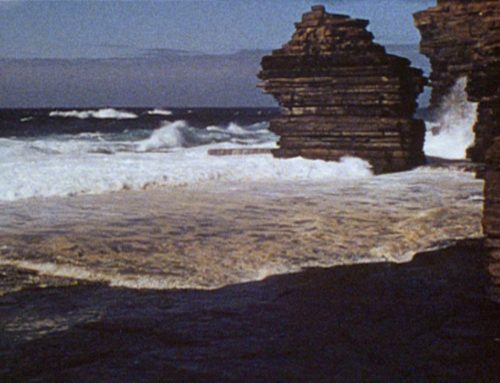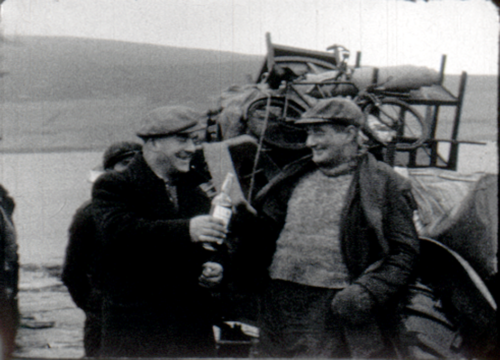Annabel Nicolson, Peter Todd, Ute Aurand, Sarah Wood: ‘Remembering Margaret Tait (1918–1999)’, compiled by Peter Todd.
A writer whose openness of mind, voice and structure all come from the Beats maybe, and Whitman crossed with MacDiarmid, but then cut their own original (and crucially female) path. A unique and underrated filmmaker, nobody like her. Born of the Italian neo-realists, formed of her own Scottish pragmatism, optimism, generosity and experimental spirit, and a forerunner of the English experimental directors of the late 20th century. A clear example of, and pioneer of, the poetic tradition, the experimental tradition, the democratic tradition, in the best of risk-taking Scottish cinema. – Ali Smith (read online)
Annabel Nicolson

Arriving in Orkney by boat from Scrabster. The strong colour of the sea and the amazing light. Standing on the deck, not wanting to miss anything.
A small blue open truck was waiting for us. On its side the words Ancona Films. I sat on the back in the wind, flying past fields. It seemed so fertile compared with the Highlands. Margaret Tait’s family home in Kirkwall, which she had known all her life, was being compulsorily purchased by the local council to make in to flats. She and Alex were in the process of moving when we visited and I was given a small room with bare floorboards and beautiful dark wooden furniture.
We had an evening looking at Margaret’s films with relations and friends, some of whom were in the films. It all felt so natural, the quiet sense of ease. I remember the openness with which Mike Leggett and I were greeted.
I wondered how Margaret could bear to leave her old home but she seemed quite philosophical about it. We moved with them to Aith, a much smaller house on its own, near Skara Brae. I still think it was remarkable that they were able to welcome us at such a time.
Peter Todd
Margaret Tait was born on Orkney on Armistice Day, 1918 and died on Orkney in 1999. She attended boarding school in Edinburgh, (from age 8/9 to 16), followed by medical studies at the University. During the Second World War, she served at home and abroad (Far East) with the Royal Army Medical Corps. Post-war visits to France and Italy culminated in full-time study at the film school (Centro Sperimentale) in Rome. In the late 1940s, she worked in hospitals and undertook locum work at various places around the UK. Based mainly in Edinburgh from the early 1950’s, she moved to East Sutherland in the mid 1960s. A few years later she settled back on Orkney. Her first film was made in 1951, and her last completed in 1998. Her one feature film, Blue Black Permanent was made in 1992. She also published three books of poetry and two of short stories (one for children) in the space of two years between 1959 and 1960.
After the retrospective of her short artists’ films at the 1970 Edinburgh International Film Festival, her work started to be more widely seen, and known. From 1979 she chose to enter some of her films for distribution through the London Film Makers Co-op. Her determination, or ‘persistence’‚ as she would say, led to the making of over 30 films, mainly self-financed.
Visiting Orkney in April 2002 brought home how Tait was very much an artist film-maker. By using images and sounds from the environment in which she lived, she was closer in approach to an artist, poet, or composer, than the jobbing life so often associated with more mainstream film-making. She explored and revisited landscapes, sounds, and people familiar to her since childhood. Preserved neatly in albums are photographs from the 1930s of different parts of Orkney (such as Yesnaby, which would be revisited in Blue Black Permanent), family, outings, picnics, boats, landscapes, seascapes, snapshots.

Her early photographs include aunts and uncles and her mother and father; also her brothers, whose own children will later appear in several of her films. After Three Portrait Sketches, filmed in Italy, she would film her mother in A Portrait of Ga. There is little evidence of Tait’s appearance in her films apart from a sequence of shots in The Leaden Echo and the Golden Echo and fleeting appearances at the end of Three Portrait Sketches and Happy Bees.
Tait was a keen cinemagoer throughout her life, and had a great interest in, and knowledge of, other art forms. She remained a champion of Jerry Lewis, ‘French’ in her appreciation of his films. In her early films there is some exploration of the documentary form, driven in part by a desire to see if it was possible to make a living through this work. This can be seen in The Drift Back, which was sponsored by Orkney Council.

A relaxed use of poetry, music and painting can be seen in Colour Poems and Garden Pieces. She made several short animated films and later integrated sequences of animation (often painting/working on the film stock), into other films, in particular the films mentioned above. Shortly before her death we were corresponding about a proposed programme exploring animation in films, and one of the films she suggested, Fiddle De Dee by fellow Scot Norman McLaren, was included in the tribute screening at The Lux cinema in London after she died.
Images of Orkney
Images recur; poppies, the garden, flowers. The child walking along the kerb is echoed by the walk of the poet in Hugh MacDiarmid A Portrait. Images of the sea also reappear, as sources for trading, and boats, such as the Shetland Trader and the Islander in the harbour, or the visiting cruise ship. These boats would be known to the islanders, their sailing times marking out the day. The unpredictability of the sea is evident in the powerful change in tone in the first part of Happy Bees, from the children in the garden to the view of the sea and cliffs, echoed in Blue Black Permanent and its seas for swimming and looking at, but also for being overcome by, swept away.

Images of the social, the communal, politics or the political feature in Tait’s films. North Sea oil; the crowd of demonstrators filling a street with their presence; banners against proposals to drill for Uranium on Orkney; and the Greenpeace boat, Rainbow Warrior, at harbour. Tait records parades and events, including dignitaries like those seen coming out of an event during the St. Magnus Festival (the composer Peter Maxwell Davies is seen in the group), as well as the old soldiers marching in Colour Poems.
Her images show the changing seasons, the winter scenes of Aerial; the largely treeless Orkney landscape, both wide open and intimate. There are records of family, friends and familiar buildings such as the croft of Land Makar and the former family home, now divided into flats.
Process
When working, Tait edited the picture first, and added the sound afterwards, a technique she had learnt in Rome. The films were edited on a single track pic sync, with dubbing work and film processing done at studios in London. Her medical training probably helped when writing the detailed production notes she sent accompanying them.
On most of her films Tait used a 16mm clockwork Bolex camera with fixed lenses. Her final camera, a Bolex with a zoom lens, was used on her last film, Garden Pieces. She also moves between the camera on a tripod in Rose Street to the drifting, breathing, and intimate hand-held camera that mark immediacy and engagement in A Portrait of Ga and Hugh MacDiarmid: A Portrait. The work she put into editing her films, each film evolving, will surely come to be more acknowledged. A process which involved editing, then projecting the work in progress, invariably to Alex Pirie, and then working on it again. She often reworked and reused bits of film and sequences, and in one case included the whole of an earlier film, Rose Street, in the later On The Mountain.

Many of the films seem just to emerge in their own time and space, with images and sounds blending or changing as if they were somehow always like that… formed without the unnecessary, the clutter of things… Tait’s films seem so fresh that it is as if they had just been created. Her skill and experience in editing made this possible, just as it had in collecting the images and sounds to use; revisiting material and selecting. The work that went into her films could be seen physically in her place of work, as the actress Gerda Stevenson wrote in her tribute:
“She drove me one day, in the back of her rattling small van, down a winding Orkney seaside road, to the old kirk which was her work-base, the hub of Ancona Films… Every inch of floor was covered in leaning towers of dusty film-reel cans – her life’s work.”
Also in her studio would have been the unmade projects, like the feature length script, The Lillywhite Boys, unpublished stories and poems, and film images and recorded sounds that may or may not have been used at some point.
The films can stand for themselves, but the person behind them lived in the real world and had experiences that others have had. She was the child so dismayed by the nature of her boarding school that she worked so as to complete her studies and gain time on Orkney before returning to University to take up medical training. Margaret Tait’s films are a record of a certain period, of a family, of Edinburgh and Orkney, each of them a repository of her memories and imaginings of all the phases of her life.
With thanks to Alex Pirie and Sarah Christian
Ute Aurund
It was in the summer of 1995 when I went north to visit Margaret Tait in the windy Orkney Islands. Two years earlier a friend mentioned her as a personal poetic film maker who would interest me, so when I came to London I watched all the prints the Co-op had and was so excited about them that we brought copies to Berlin to distribute and screen, and later to many other venues in Germany and Switzerland.

So there I was in Margaret’s kirk, her studio, in an old Orcadian church. But the most beautiful hours we shared together were watching all the films I hadn’t seen – in her dark-green painted small living room with a golden framed screen, the size of a painting… the most beautiful cinema! A moving painting!
Some days later Margaret showed me her ‘script’ Video Poems for the ’90s, which she wrote after Scottish television had asked her for a 12 minute script, but they didn’t want to realise it. Margaret thought about it as a kind of model, which others could also use to make a film from. So she asked me if we wanted to film two ‘Poems for the ’90s’ – and we took our Bolexes, and went to the edge of the sea, looked for rust, and birds and filmed, turning a page… It was very nice working together out there in the Orcadian countryside with Margaret Tait filming with her Bolex, which she hadn’t used for a long time, as she had been so involved in her 35mm film Blue Black Permanent and now she was working on a new feature script.
We didn’t finish the film poems but it was an unforgettable beginning… with no end.
Margaret Tait: Video Poems for the ’90s
With Celtic art – Celtic culture – very much in mind. ie. (inc) the end in the beginning, the beginning in the end (eg. intertwined serpents with the head swallowing the tail) in so much of Celtic design – jewellery, book illumination, crosses, stonework…
Animated title using this design idea- then nine themes, interlocking:
1. A child reading – a ‘simple’ image contemplating the intent way in which a young child reads, or looks at a book, meeting the world of story-book or picture book: – Hold it – Hold it simple – Hold it direct.
2. The edge of the sea. Literally the very edge where the shore meets water – life on both sides (here MT has a little drawing of edge of sea). A symbol but also a reality.
3. Birds in the wilderness – (“Here we sit like birds in the wilderness”) Real birds – Real wilderness. (“In and out the dusty bluebells”) (Melancholy bird calls) (Bees).
4. Stock on the Road. Touch of incongruity, touch of ‘what are they doing there?’, whiff of ineffable sadness (if not tragedy) in the fate of all creatures – Insistence through several instances of stock-moving, stock straying or finding its way out- or being driven along willy – nilly…
5. Rust everywhere. Plenty of instances of this. Rather inanimate, rather static, but nevertheless, implied in the crumbling machinery, the dwindled fencing and gate posts is that nothing stays the same.
6. Heavy traffic. Oh, yes! Far from rusted yet. The maintained, the oiled, the useful, the busy.
7. Flight to and from – comes out of 6 – Articulated lorries entering the ferry, heavy car doors, the leaving and the arriving – Aircraft, different sizes, up and away, down and in – Sailboats and other boats – A busy scene – Where do they all come from? Where are they all going? The birds too they flock and wheel and prepare to leave. Flight of individual birds.
8. Crash of a wave – a direct statement – an irrefutable image.
9. Turning a page. The quiet page-turning by the grown person – (with echoes perhaps of a device used in many film titles). Then animated decoration again in the end titles.
Sarah Wood
In her film A Portrait of Ga, there’s a close up sequence of Tait’s mother’s hands unwrapping a boiled sweet. The camera pauses, watches the process, allows for the action to gather meaning, exploring its own intimacy. Tait’s steadiness of shot is about looking for the mystery that makes something alive, the movement between frames, the transition from second to second, the imperceptible.

There’s a similar shot in the Trilogy by the other great poet of Scottish cinema, Bill Douglas, where the boy in the film fills a cup with boiling water, flings the water out of the cup and closes his grandmother’s hands round the warmth held in the china. It is an act of grim tenderness on the part of the boy and an act by Douglas to make the tender into art, to find in the real, a moment to transfigure. In Tait’s close up the opposite occurs. The consideration of the commonplace in her film reveals the texture of being alive.
Tait’s films are about unexpected life. In the short film about her mother, Tait debunks biography and shows the person revealed in contradictions – tough and girlish – never fixed. Tait’s ability to pause, to consider, constructs a new way of seeing: an unflinching gaze that squares up toughly to complexity. Leaving a Tait film, you are gifted, your eyes are opened wider to the world.
I used to lie in wait to
See the clover open
Or close,
But never saw it.
I was too impatient,
Or the movement is too subtle,
Imperceptible
And more than momentary.from Now, Margaret Tait (in Origins and Elements)
Originally published in Vertigo, Vol. 2, Issue 7 (Autumn–Winter 2004).
Peter Todd is a film maker and curator based in London. Todd has produced various projects that present and explore the work of Margaret Tait, including a major retrospective of Tait’s work at the Edinburgh International Film Festival (2004), and an international touring programme entitled Subjects and Sequences in partnership with LUX. The accompanying book Subjects and Sequences: A Margaret Tait Reader (LUX, 2004) was co-edited with Benjamin Cook (Director, LUX) and together they also produced a DVD of selected films by Tait. In 2002 Todd received Scottish Screen Exhibition Development Award funding for research on Margaret Tait with a view to preserving and making available her work. In 2006 he was funded by Pier Arts Centre, Stromness Orkney in regarding developing the collection to include work by Margaret Tait including 16mm prints and DVDs. Todd has presented Tait’s work at BAFICI Buenos Aires, MoMA New York, MIFF Mumbai, Tate Modern London, Pier Arts Centre Stromness and Portgower Village Hall Sutherland (with Sarah Neely) amongst others. In 2018 he curated the season Rhythm & Poetry; The Films of Margaret Tait at BFI Southbank London.

